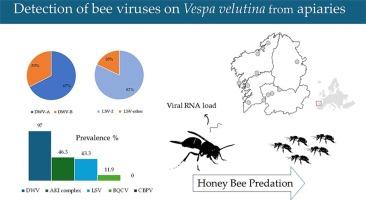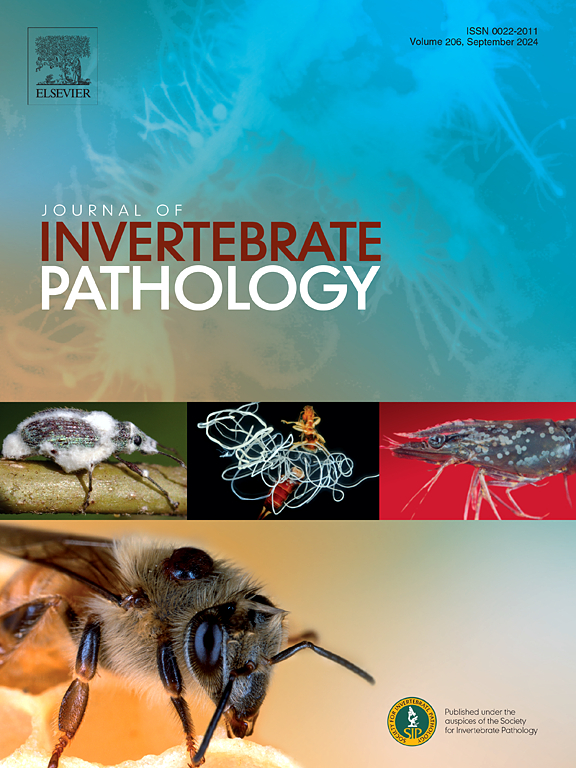Honey bee viruses in the yellow-legged hornet Vespa velutina (Lepelieter 1836): Prevalence, loads, and detection of replicative DWV and LSV forms
IF 3.6
3区 生物学
Q1 ZOOLOGY
引用次数: 0
Abstract
Apiaries in Galicia, northwestern Spain, are currently facing the invasive alien species Vespa velutina, which is well established in the region. The pressure on honey bee colonies is high, resulting in both economic and ecological losses. Honey bee colonies also face the challenge of viruses, which are becoming increasingly diverse. In recent years, honey bee viruses have been spreading across taxonomic groups beyond Apoidea, infecting the Vespoidea superfamily. This cross-species spillover has raised concerns in the scientific community due to the potential risk of viruses spreading in ecosystems. Currently, there is a lack of knowledge on this topic, and further research is needed to address this issue. This study employed qPCR and sequencing to investigate the prevalence, loads, and presence of replicative forms of important honey bee viruses in V. velutina individuals collected from 11 apiaries in Galicia. All V. velutina individuals tested positive for DWV, BQCV, AKI complex (ABPV, KBV, and IAPV), or LSV but not for CBPV. DWV showed the highest prevalence (97.0 %) and loads, with both DWV-A (67.4 %) and DWV-B (32.6 %) being detected. The AKI complex (46.3 %) and LSV (43.3 %) were also common, whereas BQCV (11.9 %) was rarer. LSV is detected for the first time in V. velutina. LSV-2 was the dominant strain (82.1 %), and two less frequent (17.9 %) unknown strains were also detected. All 44 screened V. velutina samples carried the replicative form of DWV, and six of these also carried the replicative form of LSV, raising for the first time the possibility of co-infection in the hornet. The detection of honey bee viruses in V. velutina, and the ability of these viruses to spread to other species, may indicate a potential risk of spillover in the apiaries.

黄腿大黄蜂 Vespa velutina(Lepelieter 1836)体内的蜜蜂病毒:蜜蜂病毒在黄腿大黄蜂(Vespa velutina,Lepelieter 1836)中的流行率、载量以及复制型 DWV 和 LSV 的检测。
西班牙西北部加利西亚的养蜂场目前正面临着外来入侵物种 Vespa velutina 的威胁,这种外来物种在该地区根深蒂固。蜜蜂群面临的压力很大,造成了经济和生态损失。蜜蜂群还面临着病毒的挑战,病毒的种类越来越多。近年来,蜜蜂病毒已跨分类群传播,超越了Apoidea,感染了Vespoidea超科。由于病毒在生态系统中传播的潜在风险,这种跨物种传播引起了科学界的关注。目前,人们对这一问题还缺乏了解,需要进一步的研究来解决这一问题。本研究采用 qPCR 和测序技术,调查了从加利西亚 11 个养蜂场采集的 V. velutina 个体中重要蜜蜂病毒的流行率、载量和复制形式的存在情况。所有蜜蜂个体的 DWV、BQCV、AKI 复合物(ABPV、KBV 和 IAPV)或 LSV 检测结果均呈阳性,但 CBPV 检测结果未呈阳性。DWV 的流行率(97.0%)和负荷量最高,DWV-A(67.4%)和 DWV-B(32.6%)均可检测到。AKI 复合物(46.3%)和 LSV(43.3%)也很常见,而 BQCV(11.9%)则较少见。LSV 是首次在 V. velutina 中检测到。LSV-2 是优势菌株(82.1%),另外还检测到两种较少见(17.9%)的未知菌株。所有 44 个经过筛选的 V. velutina 样本都携带有 DWV 的复制形式,其中 6 个还携带有 LSV 的复制形式,这首次提出了大黄蜂共感染的可能性。在 V. velutina 中检测到蜜蜂病毒以及这些病毒传播到其他物种的能力,可能表明养蜂场中存在潜在的外溢风险。
本文章由计算机程序翻译,如有差异,请以英文原文为准。
求助全文
约1分钟内获得全文
求助全文
来源期刊
CiteScore
6.10
自引率
5.90%
发文量
94
审稿时长
1 months
期刊介绍:
The Journal of Invertebrate Pathology presents original research articles and notes on the induction and pathogenesis of diseases of invertebrates, including the suppression of diseases in beneficial species, and the use of diseases in controlling undesirable species. In addition, the journal publishes the results of physiological, morphological, genetic, immunological and ecological studies as related to the etiologic agents of diseases of invertebrates.
The Journal of Invertebrate Pathology is the adopted journal of the Society for Invertebrate Pathology, and is available to SIP members at a special reduced price.

 求助内容:
求助内容: 应助结果提醒方式:
应助结果提醒方式:


